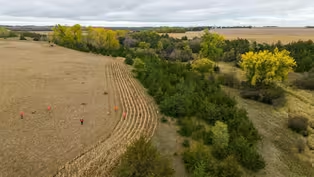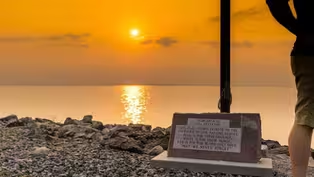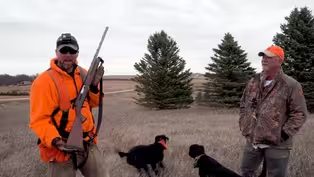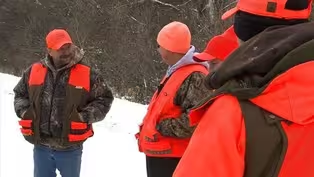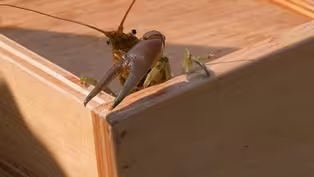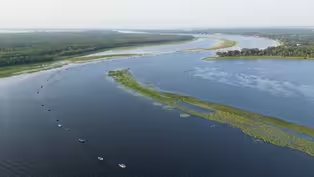Prairie Sportsman
Warrior Walleyes and Invasive Rusties
Season 16 Episode 1 | 27m 46sVideo has Closed Captions
Explore the Warrior Walleye Shootout in Lake of the Woods and researchers trap rusty crayfish.
Host Bret Amundson explores the Warrior Walleye Shootout in Lake of the Woods and researchers trap rusty crayfish on Tofte Lake to study their movement and methods for removing the invasive species from northern waters.
Problems playing video? | Closed Captioning Feedback
Problems playing video? | Closed Captioning Feedback
Prairie Sportsman is a local public television program presented by Pioneer PBS
Production sponsorship is provided by funding from the Environment and Natural Resources Trust Fund, West Central Initiative, Shalom Hill Farm, and members of Pioneer PBS.
Prairie Sportsman
Warrior Walleyes and Invasive Rusties
Season 16 Episode 1 | 27m 46sVideo has Closed Captions
Host Bret Amundson explores the Warrior Walleye Shootout in Lake of the Woods and researchers trap rusty crayfish on Tofte Lake to study their movement and methods for removing the invasive species from northern waters.
Problems playing video? | Closed Captioning Feedback
How to Watch Prairie Sportsman
Prairie Sportsman is available to stream on pbs.org and the free PBS App, available on iPhone, Apple TV, Android TV, Android smartphones, Amazon Fire TV, Amazon Fire Tablet, Roku, Samsung Smart TV, and Vizio.
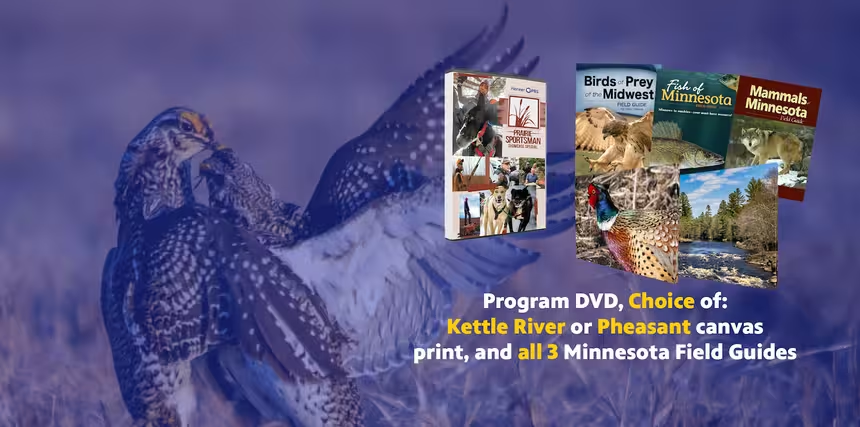
Prairie Sportsman Premium Gifts
Do you love the great outdoors, hunting, fishing, hiking and conservation? Consider becoming a friend of Prairie Sportsman to support it and receive gifts with your contribution.Providing Support for PBS.org
Learn Moreabout PBS online sponsorshipMore from This Collection
Prairie Sportsman is dedicated to telling the stories of veterans.
Video has Closed Captions
A retired conservation officer on a pheasant hunt and conservation can start at home. (27m 46s)
Video has Closed Captions
A Veterans cast-n-blast in western Minnesota and the early history of the Minnesota river. (27m 46s)
Lake of the Woods Remembrances
Video has Closed Captions
Lake of the Woods where veteran is memorialized and Amundsons hold annual fishing trip. (27m 46s)
Video has Closed Captions
Soldier who lost an arm receives a custom-made rod and reel, and inside The Raptor Center. (27m 46s)
Vets Hunt and Ag-based Solar Cells
Video has Closed Captions
Nobles County Pheasants Forever's habitat work and vets hunt and printable solar cells. (27m 46s)
The Annual Minnesota National Guard Pheasant Hunt near Holloway, Minnesota (28m 46s)
Providing Support for PBS.org
Learn Moreabout PBS online sponsorship(gentle instrumental music) (upbeat rock music) - [Bret] Coming up we're headed to Lake of the Woods for the Warrior Walleye Shootout.
- [Denny] I still can't believe, 155 boats in the water in an hour and a half.
- It really is truly another family.
(sfx whoosh) - [Bret] And then to Tofte Lake near Ely, where researchers are studying ways to remove invasive rusty crayfish.
- The Rusties, they're aggressive, they're really voracious.
- Welcome to "Prairie Sportsma” I'm Bret Amundson.
This show is all about the outdoor opportunities in Minnesota and the science management and decisions behind all those opportunities.
We got another great show for you starting right now.
(gentle instrumental music) (instrumental music intensifies) (gentle instrumental music) - [Announcer] Funding for Prairie Sportsman is provided by the Minnesota Environment and Natural Resources Trust Fund as recommended by the Legislative Citizen Commission on Minnesota Resources.
and by Mark and Margaret Yackel-Juleen on behalf of Shalom Hill Farm, a retreat and conference center in a prairie setting near Windom, Minnesota.
On the web at ShalomHillFarm.org.
(gentle instrumental music concludes) (calm instrumental music) - [Bret] Every tournament angler's unique, each favors a different style of fishing.
Some believe in weird superstitions, all prefer certain equipment.
Everyone's different, except for this tournament at Lake of the Woods, where aside from their desire to catch the biggest fish, each team has one thing in common that puts them all in the same boat.
(upbeat rock music) - What's happening down here on the shores of Lake of the Woods and Rainy River is we have the Ninth Annual David A. Andersen Memorial Walleye Shootout.
(upbeat rock music) - 155 teams.
(crowd applauds and cheers) - And it is the largest shootout we've ever had.
And as far as I know, we are the biggest walleye tournament in the state of Minnesota this year.
We started off doing, like a Warrior rally, is what they started as.
It was like our 12th annual rally And we did a few years in Devil's Lake and then we were gonna move it every couple years.
Well, we moved up, came up to Lake the Woods one year and had a great dealer meeting and a great event, bunch of people, and we're like, "Hey, what should we do with this?"
And my dad actually was the one that came up with the idea.
He was like, "Why don't we do a tournament, like a real tournament, and have an owner's tournament?"
(calm rock music) So we did that, and the first year, right before the event, if I remember right, it was, like, August 17th or something, the event, or 18th, somewhere about there.
Well, my father passed away on August 8th.
(calm rock music) Obviously, that was a huge hit to the company, huge hit to just everybody.
And Chuck called me and he's like, "We gotta cancel everything."
'Cause we had our dealer meeting scheduled and this and that.
I'm like, "No, we can't do that.
That's the last thing he'd want you to do is cancel this event."
Brett King, a great friend, great friend of the family, he actually was running Warrior at that time and reached out to Chuck and said, "We need to name this thing 'The David A. Andersen Memorial Shootout.'"
So in 2016, you know, roughly a few days after his passing, we named the tournament after him, and I think we had 38 boats that first year.
And to see what it's grown into today, it's hard to talk about 'cause it's amazing.
(calm rock music) - Kent asked me to come out to the Warrior Tournament and be a part of the event, and quickly kind of saw what was special about Warrior.
Truly, the people around the Warrior Boat family that make this a special event.
(upbeat rock music) - What makes it really special is we're a small Minnesota company.
So having all these boats come back to the great state of Minnesota, and then coming to one of the greatest fisheries there are, Lake the Woods, and it's a place that was very special to my father and it's a great place for everybody to get together.
(upbeat rock music) - Last year was a ton of fun and that's, you know, the main reason I'm back this year.
This is a great event.
One of my favorite weeks of summer.
You can't ask for a better place to fish, the Lake of the Woods.
Everybody's up here.
It's great to talk to everyone.
Been catching a pile of fish, and that's kind of what makes this event awesome.
(upbeat rock music) Pre-fishing's been up and down.
We did really good some days, bunch of those trophy 28, 29, some 30 inch fish, and then other days it was super windy and we were struggling to catch some decent fish.
So it's been all over the place.
The weather looks nice tomorrow though, finally again.
- Well, we're here because we bought our first Warrior last fall.
You know, we're just gonna try to cover as much ground and catch as many fish as quick as we can, really, you know?
We caught some nice fish in the river today, but we're gonna go out and fish the lake tomorrow.
- Stay married afterwards too.
- Yeah.
Yeah.
(Sherri laughs) There's guys that can really fish here, but you know, anybody can catch a couple of big fish each time they've been out, right?
You guys fish, you know?
I mean, sometimes just luck falls in your hands, you know?
- We'll be standing in the bow, casting at hopefully big walleyes with some forward facing and hopefully it pans out.
(music dwindles) (upbeat rock music) - So at the David A. Andersen Memorial Walleye Shootout, it's run by the "AIM Weekend Walleye Series."
Danny Fox comes up here, runs the event, and if you don't understand what the Catch, Record, Release, the CRR process is, you're gonna catch your fish, you unhook 'em, obviously, and you get a ruler.
That ruler, all those fish are gonna be measured the same, belly to belly, head in the left hand, you measure that fish, take a picture of it on the ruler, you pick that fish up, take a picture of the other side of the fish, that's the grip and grin they call it, or your hero shot, you release that fish back in the water.
So that fish is out of the water for merely 30 seconds, and he goes back in, he gets to go back with all his He doesn't have to get thrown in a live well, like most tournaments, and bounced around and drug across the stage, and loaded and unloaded.
So it's the most conservation-friendly system.
There's no better way to run a tournament, - A great day to be alive.
That's what they tell me anyways.
We've been here on site since 4:30 this morning.
I still can't believe, 155 boats in the water in an hour and a half.
(upbeat rock music) - And when you get out there in the morning at 7:00 AM and there's 150 some Warriors in line, that is the coolest part of this whole weekend.
(upbeat rock music) (engines rumble) - Here we go, boat number one!
Pat Kovatch and Bob Wagner!
(upbeat rock music) Mike Nelson, Jesse Longtime.
(upbeat rock music) Boat number one time.
One time champions out here.
Nate Gilkey and Dan Pfeifer!
- Oh boy!
(engine rumbles) Walleye.
Seriously.
- Mike Hanson and Jake Auldmen!
(engine rumbles) And rounding out in the hot top 155, it's Lance Bainville, Jacob West (engine rumbles) - [Kent] Well, it's a great day on Lake of the Woods.
Great day to be alive.
[Bret] There you go, man.
- 155 boats off to Lake of the Woods - [Bret] How's that feel?
- Feels pretty awesome.
It's actually, to be honest with you, it's a really humbling experience.
It's pretty awesome to see all these boats go out there.
Everybody's got something common and together.
It really is truly another family.
And this whole event means a lot to me.
It means a lot to Chuck.
It means a lot to everybody involved with Warrior Boats, and I hope it means a lot to everybody that comes.
And all those that can't make it hopefully they can make it here someday and experience this 'cause it is breathtaking to see what you see.
- [Brett] What do you think your dad would say seeing that?
- Oh.
(laughs) (engine rumbles) - I can't even talk.
- [Bret] Yeah.
- Yeah.
Pretty special.
(gentle instrumental music) It's not one person that makes this thing happen.
It's everyone, you know?
From the guys in the shop that build these things, because those guys take pride.
So I mean, from them, where it starts, to the dealers that sell 'em, to the customers that buy 'em, everybody has a love and a passion for the sport.
And then what's better, you get to come up to Lake of the Woods, use that product, and get together with everybody, go to Wigwam Resort and hang out with Mark and Tina, and they put on a good feed tonight.
Tons of prizes.
It's just awesome.
(calm upbeat instrumental music) Yes, everybody wants to win, but it's much more than who takes first place.
You can be out on the water and you could have 15 boats around and somebody could catch a 30 incher and all 15 boats, or other 14 boats, are gonna cheer that team on because they're all happy to see somebody have fun and catch fish.
Like, I feel if you're not that person and you're up here, you probably won't be back.
You know?
So everybody's here helping people People have issues or people have this or somebody that came from a different state that didn't know how to catch a fish here, they'll give them baits, they'll take them, show 'em way points.
Like, everybody's like, "Come on out.
We wanna catch fish."
That's what this event's about.
- That's the fun part about it is it brings a big group of people together.
It's all based around the Warrior Boat stuff.
So personally, I'm not a Warrior boat owner, but I get to fish with my really good friend Todd Zemke.
He's on the Warrior team, travels the country, fishing outta that Warrior, and we get to come together and fish together, and it's a really good time.
- We have teams from all over the upper Midwest.
I know we have teams from Michigan, we've had teams from Ohio, we have teams come down from Canada, all the way out to Montana, Nebraska.
Anywhere a Warrior's sold, I think we have people coming.
Actually, I seen one coming from Colorado today.
(upbeat instrumental music) When they come in at the end of the day, they have all their pictures.
You can score as many fish.
There's no slot you have to follow, no limits.
You check your five biggest 'cause you don't keep any.
You can't put a fish in the live well during the day today.
So you'll check your five biggest fish.
It's got a length to weight conversion chart and you do your conversion, you hand it over to Denny and the gals, they'll take it, they'll go through the SD card that they supplied you, and make sure all the pictures are good, and make sure everything matches up with your scorecard, and away you go.
And then, we do our awards at seven o'clock.
(upbeat instrumental music) - So there it is.
Thank you, everybody, for being patient.
We had a ton of fish to go through.
Let's start this off by giving a quick round of applause, to Wigwam for that fish fry and everything they do.
(crowd cheers) Let's just say this, there was more than one the record broke today.
Not only number of boats, but winning weight.
- This is the body of water in Minnesota that is the what-if factor.
Every time I've been up here, I've been shocked at what happens.
It's either your day is gonna be incredible at any cast or any trolling pass that you're gonna make.
You could catch the biggest walleye of your life.
You could catch multiple, the biggest bag you've ever caught.
- Going up 41.30 pounds, Larry and Chuck Kortuem.
(crowd cheers) - Traveling the country, you can see some of those fisheries like Erie and Green Bay that produce these monster bags and Lake of the Woods is right in there with them, if not better than them.
- With one team remaining.
- I've been wanting to fish it for three, four years ago.
Obviously, we didn't have Warriors at the time.
He finally bought one.
And we've wanted to do it for the past three years together, just didn't work out.
This year, kind of everything laid out with another tournament that's next weekend, and we just said, "Let's do it!"
- [Kent] They started of at 27 and a quarter.
- We got that, said, "All right, we at least got one.
All we need is five."
And we got that literally right away.
- [Kent] Then, they got a monster, 31 and three quarter for 13.56 pounds.
- A little while later, you know, we got some smaller ones mixed in there, and we literally looked at this one big fish for five, 10 minutes and threw everything at it and it just would not bite.
It would chase, and finally, I just told him, "Hey, put a bobber and a leech down."
Put the bobber, leech, dropped it right on his head and that bobber went down, and he set the hook on that (indistinct) rod and just keeled over.
And it was a 10 minute fight, easily.
- Oh, it took forever to get that fish in.
- But after that, we got that one in.
We're like, "All right, three more."
- They backed that one up with a 30 and a half.
- I have never gotten a fish over 30.
Something I've wanted for years, and I've come close.
And the next big one on our third big fish was 30 and a half.
I finally got that one.
- [Kent] They thought that one was a little small, so they put another 31 incher the card.
- And then, a little while later got a 31.
- [Kent] And they finished out their day with a 28 and a quarter for 935.
- He wanted to come in early and I was like, "No."
(laughs) We were gonna stick it out.
And then, I think at, like, 2:30 I got a 28 and a quarter.
- Quarter.
- And we're like, "Let's just clean up the boat.
Take it easy."
I mean- - Let's just make the long nice ride in.
If we win, we win.
If we don't, we don't.
- Yeah.
- We had a great day.
- Yeah, - [Kent] For a record setting week of 55.76 pounds.
(crowd cheers) (crowd applauds) - I looked at it, was like, "How can you really top that?"
I don't think I ever will.
It was an amazing day.
It was wild.
I mean, fishing with my best friend.
It was fun.
(upbeat instrumental music) - It's a super awesome event.
Not just being part of the Warrior family, but this whole weekend, this whole week really, whether it's talking to dealers, talking to some of the owners, giving test rides in the boat, it's truly a unique experience you don't see with other boat brands.
- It's probably the greatest tournament I've ever been part of.
Everybody's so nice, friendly, everybody says, "Hi."
I mean, the takeoff in the morning, everybody's in a line and it's a fun day.
It's a tournament, yes, but it's not your crazy go-go-go tournament.
I mean, everybody took their time, everybody was nice to everybody, nobody cutting anybody off, and it was just, "Go out there and go fishing."
- That's what this event's about is the fellowship, the friendship, the family.
(upbeat instrumental music) (chill guitar music) - [Bret] The land and waters along Minnesota's northern border have not been spoiled by many of the non-native species wreaking havoc in other parts of the state.
(chill guitar music) Still, invaders are creeping in.
Earthworms are chewing up forest floors and rusty crayfish are threatening lake shores and wild rice production.
(chill guitar music) Researchers are testing ways to kick them out.
(chill guitar music) (upbeat bass music) Rusty crayfish looked like miniature lobsters, similar to their native cousins like Calico and Northern Clearwater crayfish But Rusties are bigger, more aggressive, and sport a reddish-brown patch on their shell.
About 40 years ago, they started moving in to the upper Midwest.
(upbeat instrumental music) - The rusty crayfish is native to the Ohio River Basin.
And as far as anyone can tell, they were moved here by anglers using them as bait.
There's a couple of other theories.
Rusty crayfish, because they're easily trappable, they were one of the crayfish that they would send to high schools to, you know, learn dissections and things like that.
And so it's possible that, you know, high schools had extra and they released them.
There's also a contention that, maybe some people that wanted to catch crayfish and sell them as bait, were bringing them up and releasing them into small lakes to start populations where, because they're very trappable, they could catch them and sell 'em as bait.
(gentle piano music) They are across the whole Great Lakes region, the whole upper Midwest in 20 states.
They've even been found now in some of the western states.
The Rusties, they're aggressive, they're really voracious, they're really productive.
They start eating more of the fish eggs, they start eating more of the snails.
And so they could actually change the fish population of a lake.
They can change the vegetation on the shoreline of a lake.
So really, change that whole ecosystem.
And that's what people are upset about.
You know, we're losing our native crayfish and these aggressive things are just changing the lake.
(playful instrumental music) - [Bret] University of Minnesota researchers based at the Natural Resources Research Institute in Duluth are evaluating ways to trap and remove the invasive crustaceans from lakes.
Their work is funded by the Minnesota Environment and Natural Resources Trust Fund - We designed this project because we heard that everybody was worried about wild rice because of rusty crayfish.
Though, rusty crayfish can go in and just literally just chop off the wild rice.
We can't control rusty crayfish statewide on our own.
But we thought, well, if there are lake associations or tribal groups that want to try to protect wild rice and other sensitive vegetation, let's see if we can figure out the best trapping methods for them to use to reduce the po and protect those sensitive area (water splashes) And so, that's what we're doing.
What bait works best?
What kinds of traps work best?
- [Bret] University researchers with three organizations to test trapping methods at Dumbbell, Caribou, and Tofte Lakes.
- [Valerie] For this lake, we're partnering with 1854 Treaty Authority and they're out helping us.
So they do half the traps, we do half the traps.
- The 1854 Treaty Authority is an Inter-tribal natural resource management agency So we are governed by Bois Forte and Grand Portage bands of Lake Superior Chippewa.
Our main concern with rusty crayfish is that they're a non-native species.
and they have a detrimental impact on the plant communities here specifically, one of our focuses is manoomin, or wild rice.
It's particularly susceptible to grazing by rusty crayfish.
So we did some exclosure/enclosure work where we fenced off areas of wild rice and then either trapped and removed all the rusty crayfish from within that enclosure or stocked rusty crayfish in their And then, you know, as the summer went on, we just documented the growth of wild rice within that fenced in area.
We found that, you know, with a lack of rusty crayfish within an area, the wild rice tended to grow better.
If we stocked a bunch of crayfish in there, then they ate all the wild rice.
(upbeat percussive music) - [Bret] In early August, we joined researchers on Tofte Lake near Ely.
(upbeat percussive music) - When we were here earlier at this lake, we marked the crayfish.
So we put pinholes in their tails and those pinholes tell when and where we caught this crayfish so that if we recapture them, we'll be able to see, "Okay, how far did it go?"
This is to be able to tell people how far away from your wild rice bed, for example, do you have to set traps in order to really reduce the population?
(upbeat percussive music) So the two boats are gonna go in and start working on these traps They're gonna be pulling up the dumping out the crayfish, (crayfish thumps) ID-ing them 'cause we lkhave a mix of native and invasive crayfish in this lake.
And then, the native crayfish get put back, (water sloshes) the invasive crayfish, we measure them, check to see if they've been marked, and then the invasive crayfish get killed.
(upbeat percussive music) 1854 crew just pulled in a trap.
You can see these are standard minnow traps.
All we've done is make the opening a little wider so the crayfish can get in easily 'cause if they can't get in easily they're not gonna go in.
(upbeat instrumental music) - [Bret] Researchers determined hot dogs are the best bait for attracting crayfish.
- Rusty crayfish are omnivores.
They will eat anything that they think is munchy.
And of course, protein is a good you know, a good food source.
So what we believe is that they have chemo sensors.
They can sense carrion, the chemicals that come off of decomposing meat, and they'll follow it up current to wherever that is.
And we all know they eat, you know, dead fish and decaying stuff in lakes.
You see crayfish on them.
So that's what they're doing with a hot dog.
(upbeat instrumental music) Tried cat food and frozen smelt, and of course those two baits were a little harder to work wit Looking for the things that are easy for landowners and lake associations and tribes to use.
So hot dogs work just fine.
Hot dogs are easy.
We'll go with hot dogs.
(upbeat instrumental music) One of the things about rusties is just, they are so much more aggressive than most of the native species, and they're really territorial about food resources.
That's partly how we think they pushed the native populations out.
I have been chased around the boat by a mad crayfish this big.
Rusties are just crazy!
Native crayfish, they'll go into a defensive posture.
Rusty crayfish will actually chase you.
They get their pinchers up, and it's ridiculous.
I am, like, 200 times bigger than you.
(upbeat hip hop music) Just have the minnow traps and the refuge traps.
The minnow traps with the hotdog in 'em with a bait actually attract many more males than females.
And what you need for population control is you gotta get rid of the females.
So one of our ideas was that if we gave the females with eggs a place to hide, something called a refuge, we would get more females.
Unfortunately, we haven't been getting much.
We said we'd try it, so we tried it.
That's what research is, you know You don't know for sure 'til you try.
Zero's our data.
(laughs) (upbeat instrumental music) - [Bret] Many native crayfish species are only in a few lakes or river systems - [Valerie] And so you introduce an invasive into that system and you could extricate an entire species, or several species.
So they're very worried about things like rusty crayfish getting in.
And of course, now we've got the new crayfish coming in from the south, the Signal Crayfish, and it's big!
It gets lobster-sized!
We don't know how far north it will spread.
So far, it's only in the south.
But everybody's worried.
'cause this thing's huge, and much larger than any of anything we have up here.
Red Swamp crayfish, also invading from the south.
These crayfish are really marching north to get us.
(music concludes) (bright guitar music) You know, you would look at a lake like this and you would think, "It's perfect, There's nothing here."
And then, there's those rusty crayfish, right?
And then, if we go in the forest we might see that there's the earthworms eating everything.
That's why we want anglers to be very careful about their bait.
I mean, most people don't know that all the earthworms up here are invasive, and they're just denuding the forest floor and the trees can't regenerate 'cause they kill them all.
All bait should go in the trash.
Put it in your freezer It's the most painless death you can give them.
It seems cruel and harsh, but it's best for the ecology of that they not go back.
- [Bret] Crayfish are also delicious to eat.
- Minnesota Sea Grant sponsored crayfish boils with rusty crayfish.
What better way to get rid of your invasive species than to eat them?
So highly encouraged.
If anybody wants to do it, just boil 'em up good!
(upbeat instrumental music) For many years we've loaned our traps to folks in the White Iron Chain of Lakes and they've been trapping like crazy for, I think, a decade.
And it seems to be working.
(upbeat instrumental music) We've seen other studies that show that some fish can actually help control rusty crayfish populations, particularly fish that eat the eggs or eat the young.
So one of our ideas is that lake associations could do a whole lot of trapping, really get rusty crayfish populations down, and then maybe the fish could control it from there.
(water splashes) - Ideally, what we would wanna see is some kind of management tool.
If we could package this and give it to lake associations or, you know, other natural resource managers if they want to help restore vegetation beds on lakes, that would be great to see.
If we can see more manoomin on the landscape, even better.
(upbeat instrumental music concludes) - [Announcer] Stories about aquatic invasive species research are brought to you by the Aquatic Invasive Species Task Forces of Meeker, Yellow Medicine, Lac Qui Parle, Swift, and Big Stone counties, and by the Environment and Natural Resources Trust Fund.
(calm instrumental music) We can stop aquatic hitchhikers from infesting more lakes and streams by cleaning up everything we pull out of the water.
It's a simple drill.
Clean in, clean out.
Before leaving a water access, clean your boat and water equipment, remove and dispose of all plants and aquatic species in the trash, drain water from your boat, ballast tanks, motor, live well, and bait container, remove drain plugs, and keep drain plugs out while transporting equipment.
Dispose of unwanted bait in the trash.
To keep live bait, drain the water and refill the bait container with bottled or tap water.
And if you have been in infested waters, also spray your boat with high pressure water, rinse with very hot water, dry for at least five days.
Stop the spread of AIS.
(upbeat instrumental music) (gentle instrumental music) Funding for "Prairie Sportsman" is provided by the Minnesota Environment and Natural Resources Trust Fund, as recommended by the Legislative Citizen Commission on Minnesota Resources.
and by Mark and Margaret Yackel-Juleen on behalf of Shalom Hill Farm, a retreat and conference center in a prairie setting near Windham, Minnesota.
On the web at ShalomHillFarm.org.
(gentle instrumental music)
Video has Closed Captions
Clip: S16 Ep1 | 10m 41s | Researchers trap rusty crayfish to test ways to remove the invasive species. (10m 41s)
Video has Closed Captions
Clip: S16 Ep1 | 14m 57s | Warrior boats hold the David A. Andersen Memorial Walleye Shootout at Lake of the Woods. (14m 57s)
Warrior Walleyes and Invasive Rusties
Preview: S16 Ep1 | 30s | Explore the Warrior Walleye Shootout in Lake of the Woods and researchers trap rusty crayfish. (30s)
Providing Support for PBS.org
Learn Moreabout PBS online sponsorship
- Science and Nature

Explore scientific discoveries on television's most acclaimed science documentary series.

- Science and Nature

Capturing the splendor of the natural world, from the African plains to the Antarctic ice.












Support for PBS provided by:
Prairie Sportsman is a local public television program presented by Pioneer PBS
Production sponsorship is provided by funding from the Environment and Natural Resources Trust Fund, West Central Initiative, Shalom Hill Farm, and members of Pioneer PBS.



